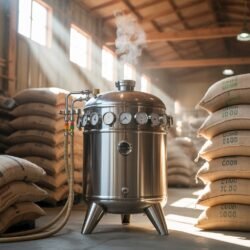Climate change has had profound and far-reaching effects on coffee growing regions worldwide, threatening both the quantity and quality of coffee production. Key impacts include:
Reduced Yields and Shrinking Suitable Land:
Rising global temperatures and shifting rainfall patterns are making it increasingly difficult for coffee plants—especially Arabica—to thrive in their traditional regions. The Intergovernmental Panel on Climate Change (IPCC) predicts a significant drop in coffee yields and a shrinking of suitable coffee-growing land by 2050, with nearly half of current coffee-growing areas potentially becoming unsuitable for cultivation.
Increased Vulnerability to Pests and Diseases:
Warmer conditions have expanded the range and activity of pests like the coffee berry borer and diseases such as coffee leaf rust. These threats are exacerbated by erratic weather, making crops more susceptible to outbreaks and reducing overall productivity.
Extreme Weather Events:
Coffee-growing regions are experiencing more frequent and severe droughts, floods, and unseasonal frosts. For example, prolonged droughts and extreme temperatures in Brazil’s Cerrado Mineiro region have led to irreversible productivity losses and physiological stress in coffee plants.
Changes in Coffee Flavor and Quality:
Climate change can alter the acidity, sweetness, and overall flavor profile of coffee beans. Erratic rainfall and temperature fluctuations disrupt the delicate balance needed for optimal bean development, sometimes resulting in less desirable taste profiles.
Shifts in Coffee-Growing Geography:
As traditional lowland and foothill regions become less hospitable, farmers are being forced to move coffee cultivation to higher altitudes. However, this is not always feasible due to limited available land, competition with other crops, and the risk of deforestation as farmers clear new areas.
Economic and Social Consequences:
Declining yields, increased production costs, and greater risk of crop failure are driving up coffee prices and threatening the livelihoods of millions of smallholder farmers. The FAO notes that adverse climatic conditions have already driven coffee prices to their highest levels in years, with further increases possible in 2025 if major growing regions face additional supply reductions.
Adaptation and Sustainability Efforts:
Farmers and industry leaders are responding by adopting sustainable practices such as agroforestry, shade-grown coffee, improved irrigation, and integrated pest management. These strategies help mitigate some climate impacts and support resilience, but significant challenges remain.
In summary, climate change is reshaping the global coffee landscape, reducing yields, increasing risks, and threatening the future of coffee production in many traditional regions. Adaptation and innovation will be crucial for the industry’s survival and continued supply of high-quality coffee.


